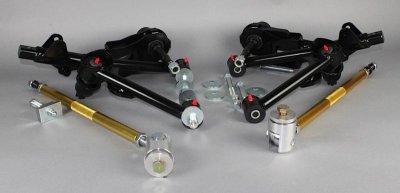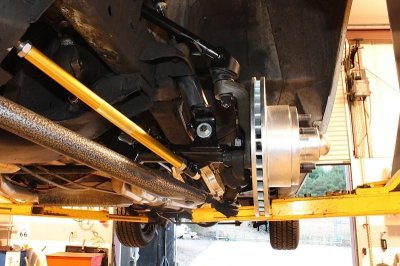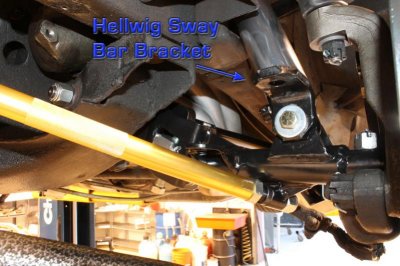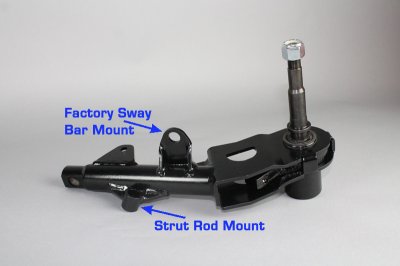Thanks, Budnicks!
Regarding the Ford Solenoid, They have 2 large lugs and 2 small ones. The two small ones are the triggers to close the gap between the two large lugs.
For me, the battery sits in the trunk. The POS cable runs to one of the big lugs. The other big lug has the 1/0 starter cable that runs through the trunk, across to the drivers rocker panel and up through the firewall to the starter. As I said, the 1/0 cable is dead when the engine is off or when it is running. It is only live when the starter is spinning. This is much safer than what I have seen others do where the cable is live all of the time. Imagine you are in a crash or if the Ammeter decides to short out....That big cable would carry the same current and possibly set the interior on fire.
Okay. The Ford Solenoid has battery power in through the RH big lug and out through the LH big lug. Next, you need to make the starter spin by way of the factory wiring. This is done by running power to the factory Mopar starter relay. I ran an 8 ga wire from the RH big lug on the Ford solenoid to the big lug on the Mopar starter relay. Now the car will have power for all accesories in the car as it did with the battery in the stock location. Headlights, brake lights, dome light, horn.... anything that works without turning the key. NEXT is the "trigger" wire. I used a 12 ga wire and connected it to one of the 2 small threaded terminals on the Ford Solenoid, then ran it through the car and connected it to the small terminal on the Mopar starter relay. NOW the cars "key-on" accesories will work: Radio, wipers, heater fan, etc. You can turn the key to start but it will not engage the starter yet. The final step is to add a small jumper wire at the starter terminals. Remember that the big terminal has that 1/0 cable on it? To make the starter spin, both terminals need power. You make a small jumper wire and connect the two or just make a "bridge" out of some metal.
It goes like this: You turn the key to the RUN position. The Mopar relay sends a signal through that 8 ga wire to the Ford relay to power up the car. You keep turning the key
further to the
cranking position, and the Mopar relay sends a signal through the 12 ga wire to the Ford solenoid to join the input and output of the battery Positive. THIS sends power directly to the starter. Once the car starts and you release the key, the power to the starter is killed but the power to the cars wiring is still provided through the 8 ga wire.
I had plenty of help when I figured this one out. 383 Ron was a big help. I read and posted on a few different forums about this very thing. Once I put my hands on it all, it became clearer.
- - - Updated - - -
I also love the fact it's really drive-able too, function over style so to speak, but your has both, style & function, very tastefully done too I may add....
Nice words, thanks a bunch.
In 2003 when I finished the car, I loved how it looked but was nervous almost every time I took it anywhere. I wouldn't dare leave it parked out of my line of sight for fear of theft or damage. It wasn't nearly as much fun driving as it was with the beat up body and faded paint.
My first trip from Sacto to LA was an easy go. I caravanned with a buddy in a nice 69 Dart. Some know him here as Darius Baker. There were no problems of any kind in the 1000 miles. It really was an eye opener and it made me feel more comfortable about driving the car. That was 2011. Since then I have gradually felt less nervous driving it. Since 2003 it has been a reliable car and has never left me stranded anywhere, but it took me a long road trip to realize this: It is a car that was built in December 1969 and rebuilt in 2003. If anything breaks, I can fix it. If it gets stolen, I'll find another and build it. These cars come apart with wrenches, sockets and screwdrivers. As beautiful as we restore them, they are still just a collection of parts that we sweat on, bleed on and beat on.
*********************************************************************************************
Heres another little nugget: Before the trip to Spring Fling this last Spring, I pulled the interior and laid down sound deadening mat from the firewall to the axle hump. I pulled the door panels and put some on the backsides of the door skins, then more on the insides of the quarter skins below the quarter windows. The car was much quieter for the trip, but the Flowmasters kept it from sounding like a newer car. I may consider a quieter muffler before my next long road trip.




















